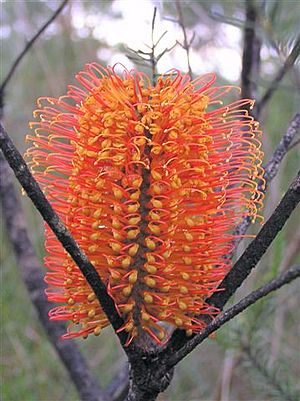Banksia sect. Oncostylis facts for kids
Quick facts for kids Banksia sect. Oncostylis |
|
|---|---|
 |
|
| The flower spike of Banksia ericifolia. You can see the hooked pistils and how the flowers open from top to bottom. | |
| Scientific classification |
|
| Kingdom: | Plantae |
| Clade: | Tracheophytes |
| Clade: | Angiosperms |
| Clade: | Eudicots |
| Order: | Proteales |
| Family: | Proteaceae |
| Genus: | Banksia |
| Subgenus: | Banksia subg. Banksia |
| Section: | Banksia sect. Oncostylis Benth. |
| Series | |
Banksia sect. Oncostylis is one of four main groups within the larger Banksia subgenus. This group includes Banksia species that have unique, hooked parts in their flowers called pistils.
Most plants in the Oncostylis group have flowers that open from the top of the flower spike downwards. However, one plant, the Banksia nutans, is different. Its flowers open from the bottom upwards.
Contents
Groups of Banksia sect. Oncostylis
The Banksia sect. Oncostylis is further divided into four smaller groups. These groups are mainly separated by the overall shape of their flower spikes.
Banksia ser. Spicigerae
This group has seven different species. Their flower spikes are shaped like a cylinder.
Banksia ser. Tricuspidae
This group contains only one species, the Banksia tricuspis.
Banksia ser. Dryandroideae
Like Tricuspidae, this group also has just one species. It is called the Banksia dryandroides.
Banksia ser. Abietinae
This group is the largest, with 13 species. Their flower spikes are shaped like a ball or are very close to being perfectly round.
Where These Plants Live
Most Oncostylis species are found only in the southwest part of Western Australia. This means they are endemic to that area.
However, two species from the Spicigerae group are an exception. The Banksia ericifolia (also known as Heath-leaved Banksia) and the Banksia spinulosa (Hairpin Banksia) are found on the east coast of Australia.
See also
 In Spanish: Banksia sect. Oncostylis para niños
In Spanish: Banksia sect. Oncostylis para niños

